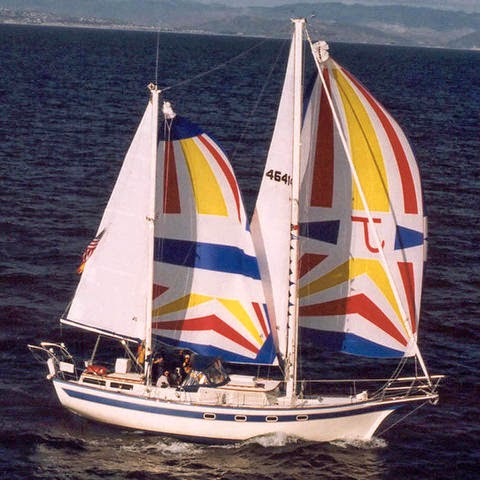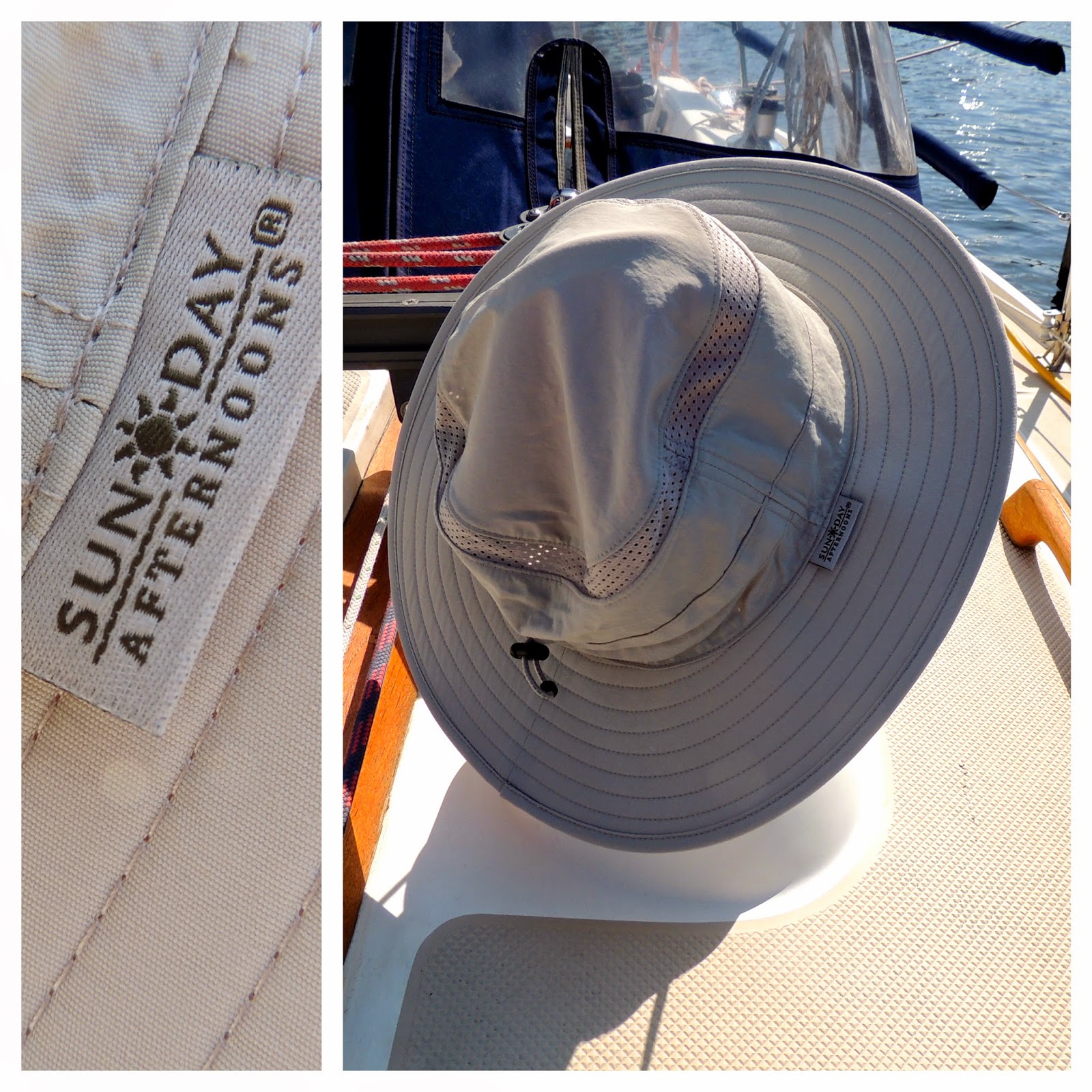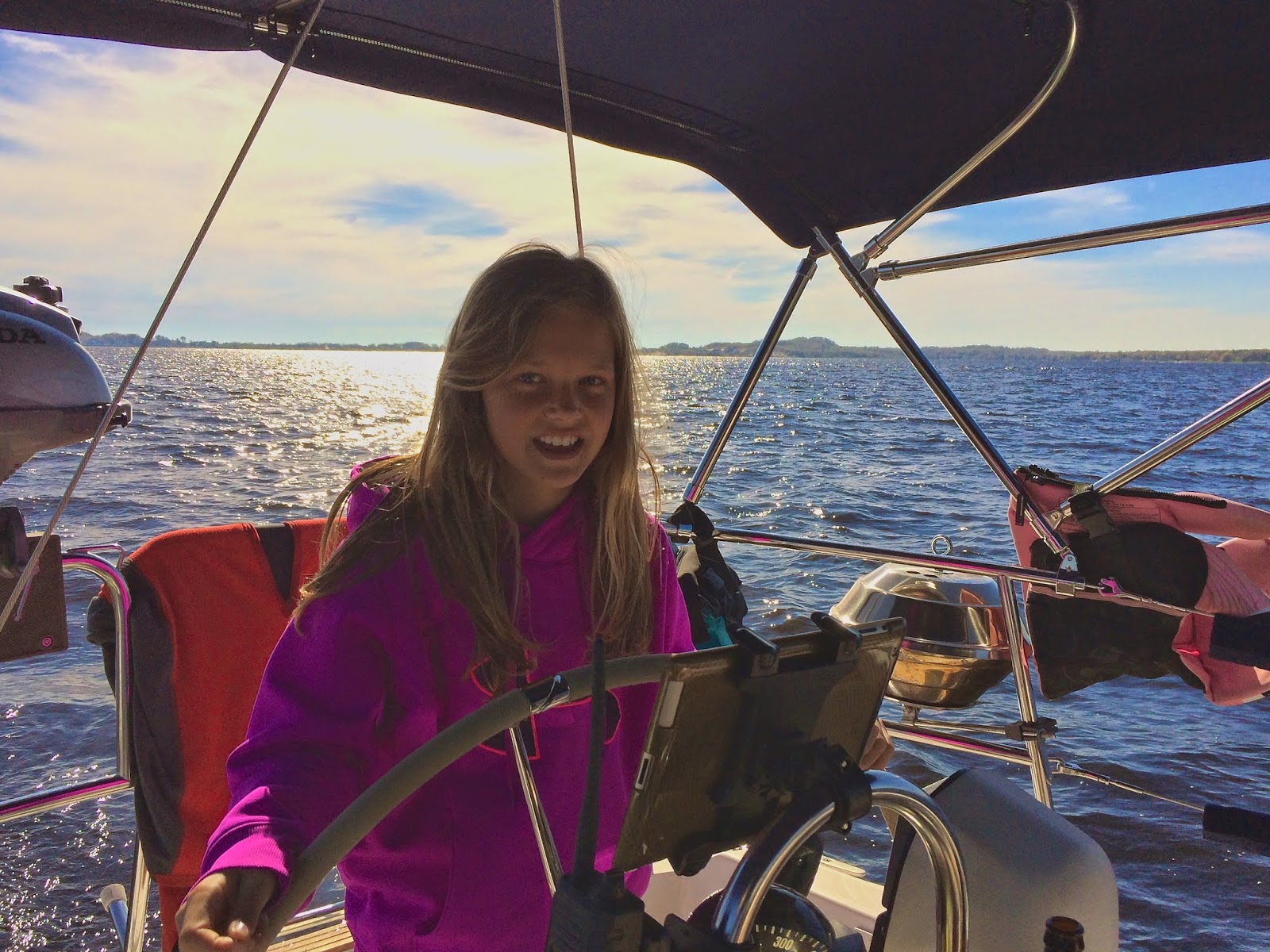"Live in the sunshine, swim in the sea, drink the wild air."
- Ralph Waldo Emerson
It seems many of the trips I plan have a mission statement similar to Emerson's prose. The sun, the sea and wild air sum it up nicely for me.
This trip began with an amber moon setting quickly in the west as we motored out the channel to Lake Michigan at about 4:45am. We raised the main and motorsailed north for about an hour before the winds were up enough for full sails and the quiet calm that comes when the motor sleeps.
And so the motor slept all the way to the Manistee channel where our first night began at the recently renovated municipal marina. The last time we were here (~2010) the shower facilities were akin to standing under a leaky pipe in a musty basement. I'm happy to report that the new clubhouse features private showers (with doors!), painted walls, and just about all the
amenities (cable TV, WiFi, nautical periodicals, etc.) many of us leave port for in the first place. Nice, casual place to give your sea legs a rest. Dinner at the Boathouse Grill was delicious too.
![]() |
| Izzy hangin' in Manistee |
The next morning we were off to the touristy, yet comfortable port of Frankfort. The sail up from Manistee was short (~25NM) but fun. The swanky Jacobson Marina Resort, a cruising boat favorite for their dock delivered lobster dinners, only had a wall tie-up available so we declined and dropped the hook in Betsie Lake for the night. Normally a night on the hook in Betsie Lake is a quiet retreat from the busy shops on Main St., but on this night we were serenaded in our berths by such melodies as 2Pac's California Love and other 90's hip hop by a wedding reception DJ across the lake. A growler of The Nightswimmer from
Storm Cloud Brewing helped us eventually drift off to sleep.
I rose with the sun the next morning and took Hannah and Izzy to shore for a donut while we waited for the fog to burn off. Turns out it didn't completely burn off until mid-afternoon. We pulled the anchor on Betsie Lake around 8:30am, but ended up dropping it again in the Frankfort breakwater as our initial departure attempt was delayed by the fog. South Manitou Island was calling, so we eventually got underway in hazy conditions.
![]() |
| The fog lifting in Frankfort |
With light west winds and the lake laying down nicely, we decided to make a detour to the south end of South Manitou Island for a close inspection of the Morazán wreck that lays dormant in about 15 feet of water. This island and this ship have been beckoning to us since
our first visit back in 2010. The glassy clear waters revealed the boulders that were out of keel's reach, but looked daunting just the same in the clear water. Those boulders must have played a role in breaking up the Morazán wreck in the time since she first ran aground in 1960.
![]() |
| The wreck of the Morazan w/ S. Manitou Island as a backdrop |
We eventually made our way around to the large crescent shaped bay on South Manitou's west shore. After setting the anchor in three separate spots (I'm a bit particular when anchoring on Lake Michigan, and for good reason - this is a deep anchorage with limited protection if the wind has any south or east to it), we were finally ready for island time.
That evening we enjoyed a family stroll along the rocky beach collecting agates, fossils and other beach treasures to someday display at home for a reminder of our favorite Lake Michigan anchorage. Don't worry, we left plenty of stones for your visit, many arranged in cairns at the water's edge. Erin's chicken and asparagus pasta filled our tummies back on
s/v Bearly A-Wake as we settled in for board games on deck under the boom.
![]() |
| Hannah & Izzy's rock cairns on S. Manitou Island |
We went back to shore in the morning hoping to take in some cultural history in the island's interior, but our attempt was thwarted by mosquitos ravenous for new blood from the mainland. The hike that took us 15 minutes on the way in lasted just 5 minutes on our sprint back out to the beach. I imagine we must have looked like Ned Land running from the natives in
that scene from 20,000 Leagues Under the Sea.
We enjoyed a smooth reach across the Manitou Passage en route to Leland. While Leland may be one of the more touristy little towns on the coast, you can't deny the charm of
Fishtown or the great facilities and knowledgeable staff at the marina. As it turns out, our slip for two nights at the marina was right next to two of the same sailboats we had anchored near a few days earlier in Frankfort. It's always fun to get to know other cruisers as the pack moves up and down the coast during the season.
A low pressure system with wind, rain and sizeable waves was moving into the region for the next 24 hours, so we took it as an opportunity to settle in a bit in Leland. We enjoyed coffee and cocoa on a swinging picnic table, flying a kite on the beach, and checking out the gardens at the Leland Village Green. But the highlights were seeing shipwrecks artifacts and learning about early Manitou island life in the
Leland Historical Society Museum and the
Animal Encounters show at the library. Soleil loved the hedgehog and parrot, but fell asleep in Erin's lap before she had a chance to see the alligator, a fact she reminded us about for the rest of the trip!
After two nights in Leland, the weather had started to moderate so we decided to leave the next morning and beat into the wind and waves until we cleared Sleeping Bear Point to the south. The rest of the long sail to Ludington was more of a sleigh ride with the wind and swell mostly behind us. Hannah and I spent lots of time on deck getting a variety of video footage using our waterproof camera, dock poles, halyards and a
Gorillapod for the recent
sailing movie we posted. Hannah and Izzy also reverted back to their North Channel cruise repertoire of turning nooks and crannies on deck into "homes" for Matchbox cars. Soleil was content to mostly play down below on her own, nap, and spend time in the cockpit with Erin and I.
![]() |
| Having fun with the camera |
We arrived in Ludington in time for a late dinner and treated ourselves to a feast at PM Steamers. The next morning we walked into town for breakfast and groceries. As mostly a reminder to myself, I'll note that my new favorite beer is
Coconut Brown from Blackrocks Brewery...tasty stuff that I found available in both Ludington and Pentwater markets. After a quick dip in the marina pool, we were headed to Pentwater for a couple of nights on the hook.
The short sail to Pentwater left plenty of time for swimming, lounging in the hammock chair hung on the spinnaker pole over the water, reading and generally relaxing for a couple of days. We intentionally left these last two days and nights on the hook as a slow, quiet way to conclude this trip and that turned out to be a good move.
We knew the trip was coming to end on the way from Pentwater back to our home port of Muskegon when the wind started to disappear somewhere just south of White Lake. But still, for the first time that we can remember, the wind and the waves seemed to cooperate for almost the entire cruise. We marked other family sailing milestones on this trip too. Our passage from Leland to Ludington was our longest continuous sail to date, covering at least 78 nautical miles beneath the keel in about 14 hours. Our initial run from Muskegon to Manistee on the first day of the trip was another lengthy sail, covering 67 nautical miles in about 11 hours.
Did we grow as sailors on this trip? Yup, for sure. Our two oldest daughters (Hannah age 11, Izzy age 9) are becoming quite competent at helping with sailing and actually enjoyed learning knots and plotting our course. Soleil (age 2) has found her sea legs and called the boat "home" several times on the way back from shore on the dinghy.
Somebody, I'm not naming any names, jibed big time on a downwind run and in so doing jammed the headsail furler, but somebody else saved the day with a trip to the bow. [Note to s/v
Bearly A-Wake captain and crew: When it's blowing 15kts from one of the stern quarters, 'tis prudent to roll in the headsail, then jibe, then put the sail back out. Or simply fast-tack through the wind.]
We also learned that our still-sort-of-new-to-us bigger boat is faster and much more comfortable than either of our previous 28 or 25 footers, but I can't muscle the sheets and halyards like I could on those smaller boats. I'm thankful for self-tailing Lewmar 45 two-speed winches! We used to spend a lot of time trimming the main with the traveler on our previous boats, but the Catalina 34 doesn't seem as sensitive to traveler position. Combine that with lazyjacks, a boom well above the cockpit and a traveler location on the doghouse forward of the companionway and our mainsail is no longer a chore to use. I'm also happy to report that we're now fully comfortable with
Navionics on the iPad as our primary form of navigation. We still have a Garmin fixed-mount plotter at the nav station and another handheld as a backup, but tablet chartplotting and instruments works well for our coastal cruising needs.
So that about sums it up. Nearly 300 nautical miles of living in the sunshine, swimming in the inland seas and drinking the wild air of the Great Lakes.
![]() |
| The three youngest crew members of s/v Bearly A-Wake on the playground in Frankfort |
![]() |
| Caribbean or Lake Michigan? |
![]() |
| Board games on deck |
![]() |
| Schooner ghosting by in the Manitou Passage |
![]() |
| Hannah, Isabel and Soleil in Frankfort |
![]() |
| Another view of the Morazan |
![]() |
| Late afternoon recreation |
![]() |
| A panorama I won't soon forget |
![]() |
| A captain and his crew |




















